Sources of False High Salt Readings Salt Water Pool
There are few topics with as many misconceptions as saltwater pools . Perhaps it all went wrong from the kickoff, when the term was coined about 40 years ago. The name certainly gives y'all the least relevant information – the pool is non salty like the ocean, and the salt in the pool isn't fifty-fifty the star of the show. So let'southward dive in. A "table salt pool" simply means that the pool has an electronic chlorine generator installed, also called a salt chlorine generator (SCG), or an SWG (table salt water generator). Put just, an SCG utilizes a depression level of salinity in pool h2o to continuously generate chlorine when the pool equipment runs every day. Despite the unfortunate confusion, it has still managed to become the standard in pool sanitationi . Notwithstanding, there's a lot of work that can be done to assistance those that treat pools understand that the differences involved when it comes to using and maintaining common salt pools and their equipment. Each of our techs work with roughly 4000-7000 customers a year on average, across all 50 states, so they have a wealth of experience when it comes to salt system maintenance. We have put together some practical, demand -to-know tips for common salt pools. Nosotros asked our techs to suggest the pinnacle 3 ideas that help prevent common troubles for people who maintain common salt pools, and these are their choices. Hopefully these insights can be useful to you: Recognize "set up -l evel chlorination" Avert "over -due south alting" Know when to replace the salt cell We occasionally get calls from customers who recently installed a SCG asking why their puddle service tech might be yet calculation chlorine to their pool. They too report finding that the SCG is turned off and chlorine tablets have been added in the pool. The reply here is that chlorine should not be manually added. A chlorine generator is meant to be the primary source of pool sanitation. That's an easy 1 to showtime with, simply let's take the idea i step farther. This leads u.s.a. to one bottom -line difference when information technology comes to salt pools. A SCG generates chlorine at the constant rate that you set, and in that location is a maximum rate at which SCG creates chl orine (depending on the model). This is "fix -level chlorination", equally opposed to the large swings in chlorination that occur with manual add-on of chlorine. When you lot're initially setting upward a pool, correctly sizing the SCG is the number one factor that is going to make up one's mind how like shooting fish in a barrel it is to care for the puddle; you lot want to maximize the chlorine output of SCG that yous chose. When information technology comes to maintaining a pool, something can happen that might surprise you if y'all're not ready for information technology: prepare-level chlorination can " bump up against " the variable chlorine need of your pool (the charge per unit at which chlorine is being used up). The idea that chlorine demand is variable is not on everyone's radar. If you oasis't thought almost it before, many factors such every bit weather, temperature, pool utilise, and particularly chemic remainder are always changing. Those factors (amid many others) determine exactly how much sanitation the pool water needs. If you lot are accustomed to adding chlorine manually, this dynamic might not be apparent unless you happen to be tracking the quantities of chlorine that you use; it's easy to go focused on the process of calculation more and more chlorine and chalking things up to doing whatever information technology takes to keep the water blue. Just getting constant chlorination from an SCG pushes the issue to the forefront. If chlorine need rises and SCG operation doesn't change, residual chlorine levels may begin dropping in the water, and the water may get cloudy. Similarly, if chlorine demand falls, you lot could find rest chlorine levels that are higher than what is desired. When you're aware of that dynamic, so you tin can hands solve the problem. For virtually people, but raising/lowering the output of the SCG on an equally-needed basis is the solution most of th eastward time. This usually only involves roughly seasonal adjustments to the SCG'due south output, or temporary boosts afterward heavy usage or storms. Generating more chlorine is e'er preferable to manually calculation shock or chlorine unnecessarily. All the same, there are many situations where the chlorine demand can fasten for reasons across predictable, normal causes like weather or pool usage. Whenever you lot observe yourself needing to raise your SCG's output, take the opportunity to check for mutual causes of rise chlorine need2. If you're having to raise your output frequently or if higher-than-boilerplate output and runtimes are needed, and so checking for imbalances becomes critical. When there is a bad enough imbalance, chlorine demand tin can ascension to the betoken that fifty-fifty an over-siz ed SCG can't go on up. Related Orenda Article: Organic Waste & Carbon Management (Pillar ii) Identifying chemical imbalances that crusade higher than normal chlorine demand allows you lot to address the root of your pool problems, rather than continuing in a vicious cycle of treating the symptoms of the problem. When yous are used to the erstwhile ways of just dumping in more chlorine as needed until the water finally clears upwardly, information technology'southward non credible to yous that there might exist high chlorine demand – you're simply always compensating by adding more chlorine. So this dynamic isn't a downside of using an SCG – in fact it'southward making you enlightened of a larger pool trouble that's usually pretty easy to solve once you know most information technology. That's a good affair, just similar if someone pointed out to yous that you have cleaved window pane somewhere in your house which was making y'all unknowingly run your home'south AC unit much harder than needed. In our experience, near high chlorine demand bug go taken intendance of by eliminating phosphates, getting rid of organic waste buildup with enzymatic cleaners, and ensuring a moderate level of cyanuric acrid. Here's a mutual situation that can unfortunately trip you up: you replace an old cell considering the SCG has been displaying error lights or giving depression diagnostic readings. Nevertheless, once the new jail cell is installed, the SCG now displays that the salinity of the pool is too high and may begin displaying a new error light! At some point, a SCG will display a warning indicator for you to cheque the system considering it thinks that its detecting low salt levels. But this may or may not mean that you need to add more common salt to the puddle. But if you add salt to your pool every time the SCG gives a alarm, you're guaranteed to eventually over-table salt your puddle. Instead, you need to know what to check. From the point of view of the SCG's diagnostics, a number of other weather condition can accept the same advent and crusade the same warnings to be displayed. If you're non prepared to troubleshoot it, a bad sort of fee dback loop volition occur. For example, when mineral scaling builds up in the SCG's cell, it volition display such warnings. Same when the SCG's jail cell gets old and depleted. Raising the salinity of the water may temporarily recoup for these atmospheric condition and clear the errors. When the issue comes back, you may be tempted to add more than salt again (and again, with diminishing returns) to clear the issue. Eventually, you lot tin can't clear the error by adding more salt, and you're left with an over -salted puddle. A SCG is ever checking the electric power passing through its jail cell. A proficient common salt level in the water makes it easier to pass power through the jail cell, and a bad salt level makes information technology harder. What is happening in the above case is that a depleted or dirty prison cell makes it harder to send power through the cell, only the unneeded addition of salt counteracts this for a time by making it a little easier to send power through. So how do you know whether you need to A) add salt, B) clean the jail cell, or C) supplant the cell? The most of import matter to practise is always test your water and independently measure out its salinity before adding more salt. You don't demand to add common salt unless the puddle water'southward salinity really drops beneath range (varies by model, often levels under 3000 ppm). Salt doesn't evaporate or break down, and the common salt that a SCG uses to generate chlorine doesn't become used upwards. Then you but ever need to add more than salt to a pool when it gets lowered due to dilution of the pool water – typically afterwards large amounts of rain or after partially draining & refilling. Call up: refilling due to evaporation does not count. If the pool water gets diluted, the low readings and alert indicators that SCG displays could be correct, and only raising the salinity will clear these errors. If the SWG's warning indicators were due to a dirty jail cell, its display readings and operation will return to normal once you restart your SCG with its cleaned prison cell. If not, your prison cell has likely reached the end of its lifespan. An SCG'due south user manual may specify a few more things to check before rep lacing your jail cell, and then be certain to bank check all relevant troubleshooting before purchasing a new one. In one case a depleted cell is replaced, any previous error lights or low readings will return to normal. We'll go into more detail about cell cleaning and how to bank check that a cell needs to be replaced in the next topic. Related Orenda Article: How to Preclude Calibration in Heaters and Common salt Cells An important note: dissimilar SCG models volition display warning indicators differently. Y'all may just be given a general "needs service" indicator, it may illuminate a "check table salt" or "bank check cell" low-cal, it may even display a message on a screen. Since every model is different, be sure to refer first to the manufacturer's documentation, but the in a higher place instructions typically apply for any combination of warnings with regard to low salt levels or jail cell maintenance indicators. For instance, a cell with a light amount of mineral scaling could potentially brandish a depression table salt warning, or an extremely depression common salt level could cause a warning to check the cell. In some ways, a salt cell is analogous to a car tire; it's a consumable role that slowly wears out as it works. Accordingly, there's non actually any benefit from replacing your SCG'southward jail cell early. Getting the longest life out of your prison cell means getting the virtually return on your investment. When a cell is depleted, the SCG's controller typically displays an mistake bulletin or alarm calorie-free; as mentioned previously, such errors can sometimes be displayed due to other related issues. These are seven troubleshooting checks you should perform before replacing your cell in order to eliminate the possibility of other minor fixable issues being the cause. Unlike a car tire, you cannot visually see when a salt jail cell is worn out so don't even endeavor. Utilise these tried and true methods instead: V erify that your pool'southward salinity is in range. As mentioned previously, you lot should independently test this; y'all can use test strips, chemical reagents, or a digital tester. Ensure that water is completely filling your cell when it is running. After confirming full water menses, a fundamental check here is to plough the SCG off then on again (while the pump keeps running). If you can restart your SCG, and information technology doesn't get an mistake within 5 -10 minutes of oper ation, that's a good sign that your prison cell is not depleted and that you lot may have a flow result. Insufficient water menstruation can allow pockets of air to class in the cell. This may be intermittently happening during the course of your pump's run fourth dimension, especially if yous accept a depression-flow variable speed pump or a solar heating system. Is your water temperature beneath 65ºF (xviii.3ºC)? The verbal temperature at which a SCG stops running depends on the model and other factors, just getting an error during the winter can be expected. Call back that a SCG measures the temperature of the water in your PVC pipes, not the trunk of the pool; as outdoor temperatures change it ' southward possible to take colder water in your pipes, especially at night or in the early morn. Carefully inspect the cable connection between your jail cell and your SCG'due south controller. Many models will give an error when the cell cable is non properly connected. Disconnect the cablevision, inspect the male and female person side of the plug connectors for damage, insect remains, moisture, corrosion, etc... and carefully but firmly reconnect the cable. We've seen instances where the prison cell cable appeared to be fastened simply was only partially continued. If your model has different "cell blazon" settings on the SCG's electronic controller, ensure that this setting has not inadvertently been inverse. Yous'll need to refer to the manufacturer's documentation to do this, simply information technology's a last particular to check which can crusade a faux mistake. If all of these other troubleshooting items appear correct, and if your jail cell has been used for a number of years (which depends on mode 50, sizing, and apply), then it'south highly likely that you've gotten the maximum amount of lifespan out of your prison cell. If you've been satisfied with its performance, you can supersede your jail cell confidently. If your current cell model didn't take enough chlorine output for your pool's needs, or i f that model's cells simply aren't lasting equally long as they should, now would be the time for you to evaluate if you need to upgrade to a different SCG system. The electronic control units that come with most SCG's last long enough for one or two cell changes but like well-nigh electronics, the engineering improves all the time. Information technology is usually wise to compare irresolute the cell vs changing the unabridged system if you accept an older model. Related Orenda Procedure: How to Implement the Orenda Program We hope these helpful tips allow y'all to troubleshoot your saltwater pool system more than easily. We deal with many different table salt chlorine generator brands, and these tips apply to all of them. Think that salt pools are chlorine pools, and that the chlorine is generated in the cell using electricity at a consequent rate during operating hours. When that electricity faces interference or resistance, like a muddy cell or low salinity levels, a warning light should occur. Follow the steps we listed here to troubleshoot it and you should be back up and running in no time. If your water quality is struggling, it could be the result of variable chlorine need meeting steady chlorine production. In that case, you can arrange your table salt system's output as necessary, and optimize pool chemistry to help address the chlorine demand. Enjoy your saltwater pool! oneAccording to data published in Pool & Spa News, an estimated 75% of new pools use a SCG compared with merely xv% in 2002. 2 Chlorine demand is dominated past the oxidant demand in the water. Oxidants are mostly non-living organics, but also include nitrogen compounds and metals. 3 Follow your manual's instructions closely, paying attention to all condom warnings. 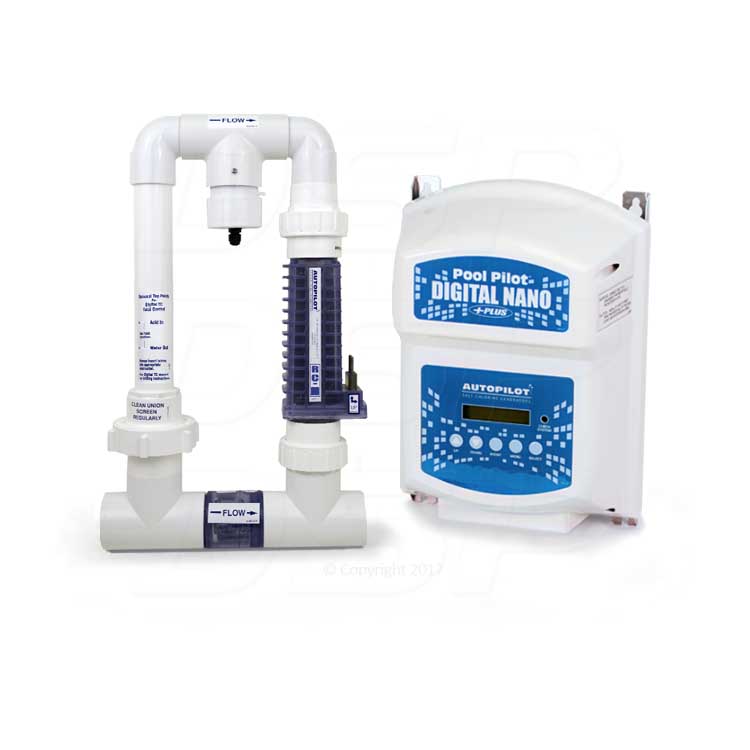
Tips for Salt Puddle Maintenance
Recognize "prepare -level chlori nation"
Variable chlorine demand
Steady chlorine production
Avoid "over -s alting"
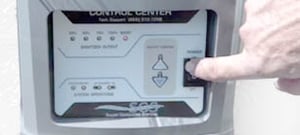 If you find yourself in this state of affairs, don't worry – yous're non solitary, and your SCG is non going haywire. This is "over - salting"; as well much salt has been added to the swimming puddle due to improper troubleshooting. We'll help you understand why this happened and forbid information technology in the future. For now, if you accept a loftier salt level, you'll need to remove a proportionate amount of h2o to lower the pool's salinity into a good range (follow all instructions in your user'due south transmission, it can vary by model).
If you find yourself in this state of affairs, don't worry – yous're non solitary, and your SCG is non going haywire. This is "over - salting"; as well much salt has been added to the swimming puddle due to improper troubleshooting. We'll help you understand why this happened and forbid information technology in the future. For now, if you accept a loftier salt level, you'll need to remove a proportionate amount of h2o to lower the pool's salinity into a good range (follow all instructions in your user'due south transmission, it can vary by model). Warnings mean electric resistance
When to add together common salt
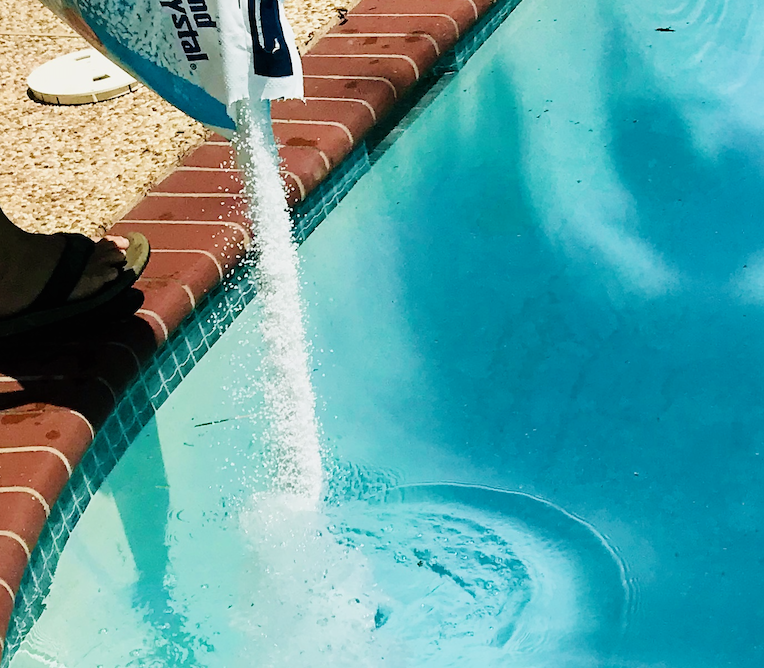
When to make clean the salt jail cell
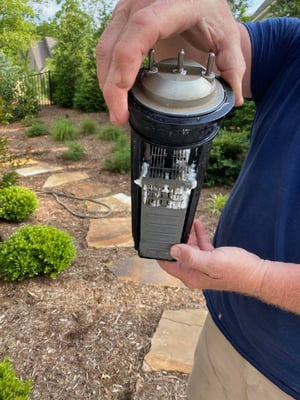 If you independently check your pool's salinity and verify that information technology'south in the correct range, the next troubleshooting step is cleaning your cell. A cell that has mineral scale deposits (and/or has droppings inside that has made it past the filter) cannot effectively laissez passer along electrical ability and o perate correctly. Clean the cell thoroughly according to your model'south user guide. Due south ometimes, multiple cleanings in a row are required. Be completely certain that no calibration or debris remain.
If you independently check your pool's salinity and verify that information technology'south in the correct range, the next troubleshooting step is cleaning your cell. A cell that has mineral scale deposits (and/or has droppings inside that has made it past the filter) cannot effectively laissez passer along electrical ability and o perate correctly. Clean the cell thoroughly according to your model'south user guide. Due south ometimes, multiple cleanings in a row are required. Be completely certain that no calibration or debris remain.
Know when to replace the common salt prison cell
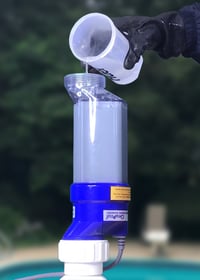 Make clean your cell today according to your model's user guide. Cleaning ways soaking t he jail cell in a solution of ane:4 diluted hydrochloric acid , not just running a hose through it or visually inspecting information technology3. When the cell is being cleaned, you lot'll see "fizzing" like to Alka-Seltzer. Make sure the unabridged internal portion of the prison cell is beingness covered by the cleaning solution. Clean information technology today fifty-fifty if you feel that information technology hasn't been that long since the last time yous've cleaned it. D epending on your puddle's LSI, it can be as little as a matter of days for scale to form if there is an imbalance. Make clean your jail cell multiple times in a row, until yous no longer encounter fizzing when you put the cell into a fresh batch of cleaning solution. This is because a jail cell with heavy buildup tin potentially utilise up the cleaning solution's acidity, especially in small-scale volumes of water or if y'all used something weak like vinegar to make clean the jail cell; this can brand information technology falsely seem like the cell is make clean. We've seen cells require iii-4 cleaning in a row to fully remove heavy buildup. Flush your cell thoroughly with a strong garden hose nozzle when done to ensure any calcium chunks or not-dissolvable debris is removed from the cell (if available, compressed air is helpful here too). Wait through the cell to visually confirm that you tin encounter daylight between all the titanium plates in your jail cell.
Make clean your cell today according to your model's user guide. Cleaning ways soaking t he jail cell in a solution of ane:4 diluted hydrochloric acid , not just running a hose through it or visually inspecting information technology3. When the cell is being cleaned, you lot'll see "fizzing" like to Alka-Seltzer. Make sure the unabridged internal portion of the prison cell is beingness covered by the cleaning solution. Clean information technology today fifty-fifty if you feel that information technology hasn't been that long since the last time yous've cleaned it. D epending on your puddle's LSI, it can be as little as a matter of days for scale to form if there is an imbalance. Make clean your jail cell multiple times in a row, until yous no longer encounter fizzing when you put the cell into a fresh batch of cleaning solution. This is because a jail cell with heavy buildup tin potentially utilise up the cleaning solution's acidity, especially in small-scale volumes of water or if y'all used something weak like vinegar to make clean the jail cell; this can brand information technology falsely seem like the cell is make clean. We've seen cells require iii-4 cleaning in a row to fully remove heavy buildup. Flush your cell thoroughly with a strong garden hose nozzle when done to ensure any calcium chunks or not-dissolvable debris is removed from the cell (if available, compressed air is helpful here too). Wait through the cell to visually confirm that you tin encounter daylight between all the titanium plates in your jail cell.
Conclusion
 About the Author: John Uhle is the Support Team Leader at Discount Salt Pool . John has over 10 years of hands-on experience with electronic chlorine generators across all brands and models. Discount Salt Pool specializes in working directly with homeowners across the country to achieve a low-chemical pool with minimal maintenance & toll, learn more here .
About the Author: John Uhle is the Support Team Leader at Discount Salt Pool . John has over 10 years of hands-on experience with electronic chlorine generators across all brands and models. Discount Salt Pool specializes in working directly with homeowners across the country to achieve a low-chemical pool with minimal maintenance & toll, learn more here .
Source: https://blog.orendatech.com/experts-blog/salt-water-pool-maintenance
0 Response to "Sources of False High Salt Readings Salt Water Pool"
Postar um comentário